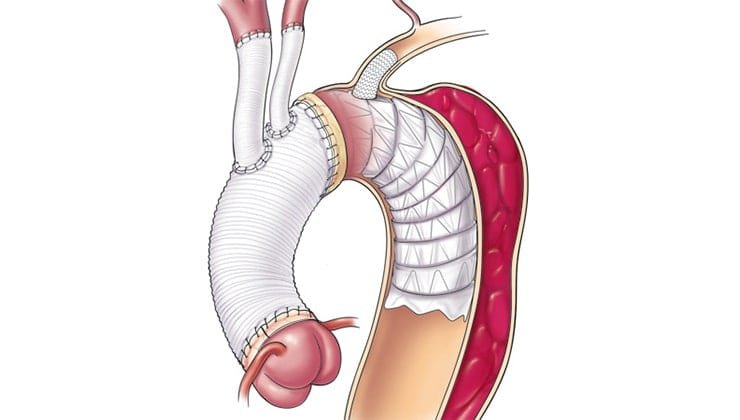Aortic dissection is a tear (dissection) in the wall of the body’s main artery (the aorta). The aorta transports blood from the heart to the rest of the body. A tear allows blood to enter between the aorta’s three layers. This decreases the quantity of oxygen and nutrients that reach your organs.
The tear can have long-term effects on your brain, lungs, arms, legs, and heart. This depends on where the tear occurs in your aorta. The treatment also depends on where the tear is located.
If the rupture is located in the ascending aorta, surgery will be necessary. This is the section of the aorta that runs up through the chest toward your head.
What is Aortic Dissection Repair?
Aortic dissection repair is a surgical procedure performed to treat aortic dissection, a life-threatening condition in which there is a tear or rupture in the inner lining of the aorta, the main artery that carries oxygenated blood from the heart to the rest of the body.
When the aortic dissection involves the ascending aorta (the portion of the aorta that rises out of the heart) they require immediate surgical intervention and open-heart surgery.
Ascending Aortic Dissection is a true cardiac surgical emergency. With a mortality rate of 1% per hour, 50% of patients with this diagnosis are dead in 48 hours!
Dr. Nikhil
Causes of Aortic Dissection
- High Blood Pressure
- Injuries from accidents
- Genetic disorders are handed down in families.
- Structural heart issues
- Smoking
Why should I go for an aortic dissection repair?
When an aortic dissection develops in the ascending aorta, it can be fatal. This is the section of the aorta that travels up through your chest and into your head. A surgeon must fix this as soon as possible.
There are two surgical options for aortic dissection repair. The first option is regular open-heart surgery. The second option is less invasive endovascular surgery. If you are not physically capable of undergoing open-heart surgery, this may be recommended.
It may also be recommended if the dissection occurs in the descending aorta. This is the section of your aorta that runs down through your chest and belly.
Aortic dissection repair is a surgical treatment that repairs a rip in the aorta. Surgeons may use one of two techniques: Endovascular or open-heart surgery
Open heart surgery
The surgeon creates an incision in the chest or abdomen, depending on where the dissection is performed. A cardiac bypass machine pumps blood as the surgeon repairs the damaged aorta with a synthetic graft.
If the aortic valve is broken, the surgeon may replace it. Once the repairs are completed, the surgeon removes the bypass machine and sutures the incision.
Endovascular Surgery
This minimally invasive surgery includes making small incisions and inserting a stent to allow the dissection to heal. It may be suggested if the patient is not strong enough for open-heart surgery or if the dissection is in the descending aorta. However, not all hospitals provide this option.
What happens during Aortic Dissection Repair?
In this procedure the patient is placed under general anesthesia, and their chest is opened through a sternotomy (incision in the chest). The patient is connected to a heart-lung machine to maintain blood circulation during the surgery.
However the most challenging part of the procedure is when the surgeon replaces the damaged portion of the aorta with a synthetic graft, effectively replacing the torn segment.
This is done under deep hypothermic circulatory arrest. In some cases, the surgeon may also repair or replace any damaged heart valves if necessary.
Or an entire root replacement will have to be done called Bentall Procedure. After the repair, the patient is gradually weaned off the heart-lung machine, and the chest is closed.
When the Ascending Aorta and Arch are not involved immediate surgery is rarely needed. Medical treatment of blood pressure is key. In some patients Endovascular stenting might be indicated.
The decision regarding which type of repair is necessary depends on the location, extent, and severity of the dissection, as well as the overall health and stability of the patient.
Post-operative Care
After aortic dissection repair, the initial recovery period consists of a one-week hospital stay, beginning in the intensive care unit until stable, then going to the regular ward. Pain and nausea medicines are available.
At home, recovery following open-heart surgery might take months, with a focus on rest, appropriate diet, and avoiding extensive activity. Blood pressure medication is often needed and if a valve is replaced, blood-thinning medication may be given.
Endovascular surgery has a quicker recovery time but requires frequent follow-ups due to potential problems such as graft leakage. Patients should avoid smoking and get approval before beginning any workout plan.
Individual health needs will be used to determine a suggested diet, and medication prescriptions must be followed exactly.
Aortic dissection repair is a crucial surgical procedure for treating a life-threatening tear in the aorta. Depending on where and to what extent of the dissection, open-heart surgery or endovascular treatment may be required.
Open-heart surgery requires a longer recovery period, but endovascular surgery is a less intrusive approach with a shorter recovery time.
Regardless of the technique, post-operative care is critical, which includes continuous monitoring, medication adherence, and lifestyle changes to avoid problems. Regular follow-ups with healthcare experts are required to guarantee a good recovery and long-term health.
Our expert, Dr. Nikhil P.J. Theckumparampil, has been trained at Harvard University, Ohio State University, Vanderbilt University, and Temple University.
To consult with our expert cardiologist for managing heart failure and other cardiac-related issues, book an appointment with our Clinic Heart360 Care, the complete cardiac care center in Chennai!


